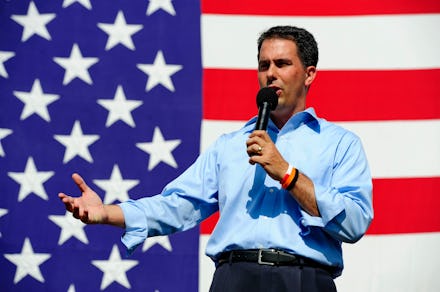The Selfish Reason Republicans Are Trying to Take Down Teachers

With gridlock and discord halting the political right’s agenda in Congress, corporations have taken the war on labor to the states. The Economic Policy Institute recently released a new report, “The Legislative Attack on American Wages and Labor Standards, 2011-2012,” authored by Gordon Lafer. The report documents a coordinated corporate attack on unions, workplace production and fair wages led by organizations like the American Legislative Exchange Council (ALEC), the Chamber of Commerce, and Americans for Prosperity.
Among other rollbacks, “Four states passed laws restricting the minimum wage, four lifted restrictions on child labor, and 16 imposed new limits on benefits for the unemployed.” These laws rarely were demanded by economic circumstances. For instance, Gov. Scott Walker’s famous push to end collective bargaining for Wisconsin’s public workers came after they had assented to “significant benefit reductions.” But the true motivation for Walker’s plan was not closing the budget gap, but rather crushing organized labor.
The report documents a nationwide crackdown on organized labor:
15 states passed laws restricting public employees’ collective bargaining rights or ability to collect “fair share” dues through payroll deductions.
19 states introduced “right-to-work” bills, and “right-to-work” laws affecting private-sector collective bargaining agreements were enacted in Michigan and Indiana.
Lafer notes that collective bargaining for teachers has been curtailed even in states like New Jersey and New Hampshire that rank in the top 10 states for educational attainment. Pension reform, which is too often merely a guise to slash benefits and divert pension funds to expensive hedge funds, occurred in states like Wisconsin, Florida, and North Carolina, where pensions were far from underfunded.
These states all share one thing in common: Republican governors. Similarly, Lafer points to evidence that the states which laid off the most workers were not the states with the highest budget deficits, but the states with the most far-right legislators. For instance, the 11 “newly red” states (those where the Republican revolution of 2010 gave Republicans total control of the legislature) and Texas accounted for 71.8% of the public jobs eliminated in 2011, but only 12.5% of the aggregate budget shortfall.
These legislators often follow to a tee the model legislation of organizations like ALEC, which are rooted not in economics, but ideology. A recent report by Peter Fisher finds that ALEC “fails to predict job creation, GDP growth, state and local revenue growth, or rising personal incomes.”
New Hampshire, for instance, repealed the minimum wage over a gubernatorial veto. The House speaker (who is an ALEC member) cited the need to stimulate job growth — presumably an ALEC talking point. But in truth, economists have found no link between a minimum wage hike and an increase in unemployment, and research indicates that a higher minimum wage can create jobs by stimulating demand.
The attack on unions is incredibly important for national politics. The Organization for Economic Cooperation and Development (OECD) data for 2008 (the most recent year for which all countries are available) shows that the unionization rate for America is far below average. This means that in America we have two parties beholden to corporate interests and no counterbalance. Demos' report, Stacked Deck, shows how politicians are more responsive to the interests of their wealthier constituents than those who are less well off. There should be no surprise that lower unionization rates correlate with higher levels of inequality. But if the union movement in America remains suppressed by powerful corporations, it’s hard to imagine anything other than ALEC-style legislation winning the day.
Similarly, the cruel austerity practiced by states actually deters growth. Adam Hersh, an economist at the Center for American Progress finds that states which cut public spending face bigger employment losses than those which don't. After the Great Depression, expansionary federal fiscal policy was undermined by state-level belt-tightening. Across the country, Republican governors have passed radical tax cuts, and then used the budget hole to justify cuts to public services. This strategy makes voters feel they have no other option. But as Lafer notes,
Indeed, if elected officials were simply concerned with closing budget gaps, they had many alternative methods for achieving this end without cutting essential services. For instance, in 2011 the deficits in all 50 states could have been erased entirely through two simple policy changes: effectively undoing the Bush tax cuts for the top 2% of income earners by imposing an equivalent income tax at the state level, and taxing capital gains at the same rate as ordinary income.
Instead of pursuing higher revenues, states slashed funding to their most crucial investment: education. Lafer writes, “In 2010–2011, 70% of all U.S. school districts made cuts to essential services.” This was coupled with new laws in four states (Idaho, Wisconsin, Michigan, and Maine) rolling back child labor standards.
Lafer argues that rather than being a “localist” strategy tailored to each state, the attack on labor has been a coordinated one, and it has been focused on battleground states: Michigan, Indiana, Pennsylvania, and Ohio. If the corporate money machine can hobble unions and public employees in battlegrounds, they can influence key national elections.